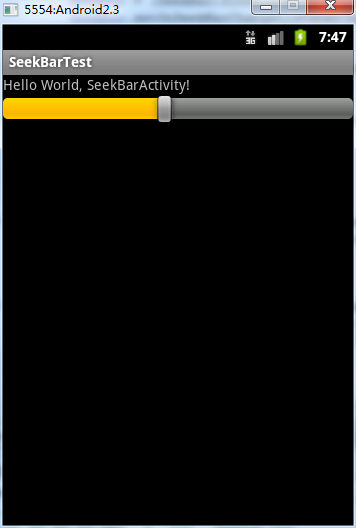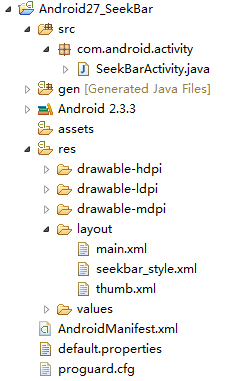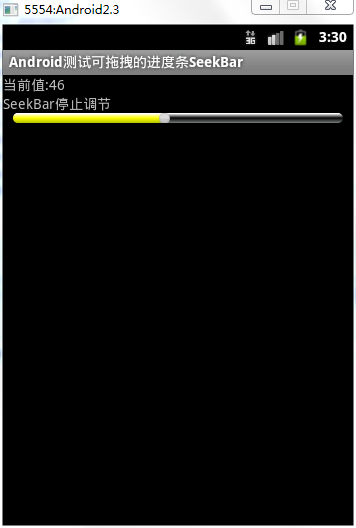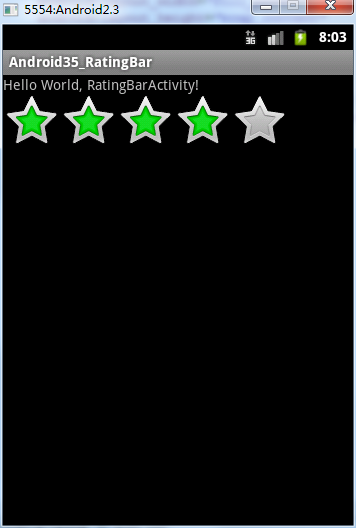?
一、使用SeekBar步骤:
?????? SeekBar一般用于进度可调的地方,比如在做音乐播放器的时候,调节音量以及调节歌曲播放进度的时候就是用的SeekBar。
?????? 1.在布局文件中声明SeekBar:
?
<SeekBar android:id="@+id/seekbar" android:layout_width="fill_parent" android:layout_height="wrap_content" />
??????? 2.定义一个OnSeekBarChangeListener:
?
class SeekBarListener implements OnSeekBarChangeListener{ //当进度条发生变化时,就会调用该方法 public void onProgressChanged(SeekBar seekBar, int progress, boolean fromUser) { System.out.println(progress); } //当用户开始滑动滑块时调用该方法 public void onStartTrackingTouch(SeekBar seekBar) { System.out.println("seekbar start:"+seekBar.getProgress()); } //当用户结束对滑块的滑动时调用该方法 public void onStopTrackingTouch(SeekBar seekBar) { System.out.println("seekbar end:"+seekBar.getProgress()); }}?运行结果:

输出结果:

?
当然这样的进度条如果作为播放器的控件就太难看了,可以定义自己的SeekBar样式,可以尽情的去想象扩展。

?其中seekbar_style.xml是进度条的样式,thumb.xml是进度条滑块的样式。
main.xml
?
<?xml version="1.0" encoding="utf-8"?><LinearLayout xmlns:android="http://schemas.android.com/apk/res/android" android:orientation="vertical" android:layout_width="fill_parent" android:layout_height="fill_parent" ><TextView android:id="@+id/progress" android:layout_width="fill_parent" android:layout_height="wrap_content"/><TextView android:id="@+id/tracking" android:layout_width="fill_parent" android:layout_height="wrap_content" /><SeekBar android:id="@+id/seek" style="?android:attr/progressBarStyleHorizontal" android:progressDrawable="@layout/seekbar_style" android:thumb="@layout/thumb" android:layout_width="fill_parent" android:layout_height="10px" android:paddingLeft="10px" android:paddingRight="10px" android:thumbOffset="0dip"/></LinearLayout>
?seekbar_style.xml
?
<?xml version="1.0" encoding="UTF-8"?> <layer-list xmlns:android="http://schemas.android.com/apk/res/android"> <item android:id="@android:id/background" android:paddingTop="3px" android:paddingBottom="3px"> <shape> <corners android:radius="10dip" /> <gradient android:startColor="#ffffffff" android:centerColor="#ff000000" android:endColor="#ff808A87" android:centerY="0.45" android:angle="270"/> </shape> </item> <item android:id="@android:id/progress" android:paddingTop="3px" android:paddingBottom="3px" > <clip> <shape> <corners android:radius="10dip" /> <gradient android:startColor="#ffffffff" android:centerColor="#ffFFFF00" android:endColor="#ffAABD00" android:centerY="0.45" android:angle="270"/> </shape> </clip> </item> </layer-list>
?thumb.xml
?
<?xml version="1.0" encoding="UTF-8"?> <selector xmlns:android="http://schemas.android.com/apk/res/android"> <!-- 按下状态 --> <item android:state_pressed="true" android:drawable="@drawable/greypoint" /> <!-- 普通无焦点状态 --> <item android:state_focused="false" android:state_pressed="false" android:drawable="@drawable/greypoint" /> </selector>
?SeekBarActivity.java
package com.android.activity;import android.app.Activity;import android.os.Bundle;import android.widget.SeekBar;import android.widget.SeekBar.OnSeekBarChangeListener;import android.widget.TextView;public class SeekBarActivity extends Activity { //声明SeekBar 和 TextView对象 SeekBar mSeekBar; TextView mProgressText; TextView mTrackingText; @Override public void onCreate(Bundle savedInstanceState) { super.onCreate(savedInstanceState); setContentView(R.layout.main); //取得SeekBar对象 mSeekBar = (SeekBar) findViewById(R.id.seek); mProgressText = (TextView) findViewById(R.id.progress); mTrackingText = (TextView) findViewById(R.id.tracking); mSeekBar.setOnSeekBarChangeListener(new SeekBarListener()); } class SeekBarListener implements OnSeekBarChangeListener{ /** * 在拖动中--即值在改变 */ public void onProgressChanged(SeekBar seekBar, int progress, boolean fromUser) { //progress为当前数值的大小 mProgressText.setText("当前值:" + progress); } /** * 在拖动中会调用此方法 */ public void onStartTrackingTouch(SeekBar seekBar) { mTrackingText.setText("SeekBar正在调节"); } /** * 停止拖动 */ public void onStopTrackingTouch(SeekBar seekBar) { mTrackingText.setText("SeekBar停止调节"); } }}??运行结果:

?
二、RatingBar
?????? 1.在布局文件当中声明RatingBar:
????????????? android:nubStars="5":指明共多少颗星星
????????????? android:stepSize="1.0":指明每次前进多少颗星星
?
<RatingBar android:id="@+id/ratingbar" android:layout_width="wrap_content" android:layout_height="wrap_content" android:numStars="5" android:stepSize="1.0" />
??????? 2.定义一个OnRatingBarChangeListener
?
class RatingBarListener implements OnRatingBarChangeListener{ public void onRatingChanged(RatingBar ratingBar, float rating, boolean fromUser) { System.out.println(rating); }}?运行结果:

?输出结果:

?